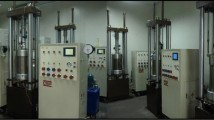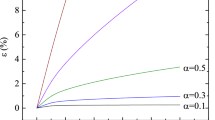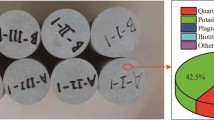Abstract
In order to accurately simulate the creep behavior of rocks under the action of complex environments, the damage creep model considering the environmental effects (hydrous conditions and freeze–thaw cycles) is investigated. Through the statistical analysis of the test results of rocks under different water contents and freeze–thaw cycles, it is believed that the rock damage includes time-independent initial damage and time-dependent subsequent damage. Then, the mathematical expression of the creep failure time of rocks is calibrated with the help of the environmental effect of the characteristic stress, and a subsequent damage factor that can describe the damage creep of rocks under the environment-mechanics interaction is given, and its numerical analysis is carried out. Ultimately, a unified fractional rheological mechanical model is established by combining the extended fractional viscoplastic theory, Drucker-Prager yield theory considering damage effect and modified effective stress. The universality of the new model is verified by the damage creep test results of rocks under different environmental loads. The result indicative of the unified fractional rheological mechanical model can accurately describe the nonlinear creep behavior of rock under complex environment, and the model simplifies the loading conditions and viscoplastic theory of the traditional unified rheological mechanical model.
















Similar content being viewed by others
References
Amitrano D, Helmstetter A (2006) Brittle creep, damage and time to failure in rocks. J Geophys Res Sol Ea 111:B11201. https://doi.org/10.1029/2005JB004252
Argyris J, Doltsinis IS, Silva VD (1991) Constitutive modelling and computation of non-linear viscoelastic solids. Part I: Rheological models and numerical integration techniques. Comput Method Appl M 88(2):135–163
Bazant ZP, Xi Y (1994) Drying creep of concrete: constitutive model and new experiments separating its mechanisms. Mater Struct 27(1):3–14
Borja RI, Sama KM, Sanz PF (2003) On the numerical integration of three-invariant elastoplastic constitutive models. Comput Method Appl M 192(9/10):1227–1258
Čebašek TM, Frühwirt T (2018) Investigation of creep behaviours of gypsum specimens with flaws under different uniaxial loads. J Rock Mech Geotech 10(1):151–163
Chen L, Wang CP, Liu JF, Li Y, Liu J, Wang J (2017) Effects of temperature and stress on the time-dependent behavior of Beishan granite. Int J Rock Mech Min 93:316–323
Chen L, Wang CP, Liu JF, Liu YM, Liu J, Su R, Wang J (2014) A damage-mechanism-based creep model considering temperature effect in granite. Mech Res Commun 56:76–82
Chen LX, Li KS, Song GL, Zhang D, Liu CX (2021a) Effect of freeze–thaw cycle on physical and mechanical properties and damage characteristics of sandstone. Sci Rep-UK. https://doi.org/10.1038/s41598-021-91842-8
Chen PZ, Tang SB, Liang X, Zhang YJ, Tang CA (2021b) The influence of immersed water level on the short- and long-term mechanical behavior of sandstone. Int J Rock Mech Min 138:104631
Drucker DC, Prager W (1952) Soil mechanics and plastic analysis or limit design. J Appl Math 10(2):157–165
Eslami J, Grgic D, Hoxha D (2010) Estimation of the damage of a porous limestone from continuous (P-and S-) wave velocity measurements under uniaxial loading and different hydrous conditions. Geophys J Int 3:1362–1375
Eslami J, Hoxha D, Grgic D (2012) Estimation of the damage of a porous stone using continuous wave velocity measurements during uniaxial creep tests. Mech Mater 49(6):51–65
Fakhimi AA, Fairhurst C (1994) A model for the time-dependent behavior of rock. Int J Rock Mech Min 31(2):117–126
Grgic D, Amitrano D (2009) Creep of a porous rock and associated acoustic emission under different hydrous conditions. J Geophys Res Sol Ea 114:B10201. https://doi.org/10.1029/2006JB004881
Han TL, Shi JP, Cao XS (2016) Fracturing and damage to sandstone under coupling effects of chemical corrosion and freeze–thaw cycles. Rock Mech Rock Eng 49(11):1–11
Hou RB, Kai Z, Jing T, Xue XR, Chen YL (2018) A nonlinear creep damage coupled model for rock considering the effect of initial damage. Rock Mech Rock Eng 52(2):1–11
Iñigo AC, Vicente MA, Rives V (2000) Weathering and decay of granitic rocks: its relation to their pore network. Mech Mater 32(9):555–560
Kachanov LM (1999) Rupture time under creep conditions. Int J Fracture 97(1):11–18
Kang JH, Zhou FB, Liu C, Liu YK (2015) A fractional nonlinear creep model for coal considering damage effect and experimental validation. Int J Nonlin Mech 76:20–28
Khanlari G, Abdilor Y (2015) Influence of wet–dry, freeze–thaw, and heat–cool cycles on the physical and mechanical properties of Upper Red sandstones in central Iran. Bull Eng Geol Environ 74:1287–1300
Kranz RL (1980) The effects of confining pressure and stress difference on static fatigue of granite. J Geophys Res Sold Ea 85:1854–1866
Kranz RL, Harris WJ, Carter NL (1982) Static fatigue of granite at 200℃. Geophys Res Lett 9(1):1–4
Lajtai EZ, Schmidtke RH, Bielus LP (1987) The effect of water on the time-dependent deformation and fracture of a granite. Int J Rock Mech Min 24(4):247–255
Liang JR, Lu DC, Zhou X, Du XL, Wu W (2019) Non-orthogonal elastoplastic constitutive model with the critical state for clay. Comput Geotech 116:103200
Lu Y, Wang L (2017) Effect of water and temperature on short-term and creep mechanical behaviors of coal measures mudstone. Environ Earth Sci 76(17):597
Ma QY, Ma DD, Yao ZM (2018) Influence of freeze-thaw cycles on dynamic compressive strength and energy distribution of soft rock specimen. Cold Reg Sci Technol 153(9):10–17
Ma SQ, Gutierrez M (2020) A time-dependent creep model for rock based on damage mechanics. Environ Earth Sci 79:466. https://doi.org/10.1007/s12665-020-09198-7
Manh HT, Sulem J, Subrin D (2015) Anisotropic time-dependent modeling of tunnel excavation in squeezing ground. Rock Mech Rock Eng 48(6):2301–2317
Martin CD, Chandler NA (1994) The progressive fracture of Lac du Bonnet granite. Int J Rock Mech Min 31(6):643–659
Masoumi H, Horne J, Timms W (2017) Establishing empirical relationships for the effects of water content on the mechanical behavior of Gosford sandstone. Rock Mech Rock Eng 50(8):1–8
Masuda K (2001) Effects of water on rock strength in a brittle regime. J Struct Geol 23:1653–1657
Miura K, Okui Y, Horii H (2003) Micromechanics-based prediction of creep failure of hard rock for long-term safety of high-level radioactive waste disposal system. Mech Mater 35(3/6):587–601
Mu JQ, Pei XJ, Huang RQ (2017) Degradation characteristics of shear strength of joints in three rock types due to cyclic freezing and thawing. Cold Reg Sci Technol 138(6):91–97
Nicholson DT, Nicholson FH (2015) Physical deterioration of sedimentary rocks subjected to experimental freeze–thaw weathering. Earth Surf Proc Land 25(12):1295–1307
Özşen H, Özsen İ, Şensöğüt C (2014) Measurement and mathematical modelling of the creep behaviour of Tuzköy rock salt. Int J Rock Mech Min 66(1):128–135
Scholz CH (1972) Static fatigue of quartz. J Geophys Res Atmos 77(11):2104–2114
Shan RL, Bai Y, Ju Y et al (2020) Study on the triaxial unloading creep mechanical properties and damage constitutive model of red sandstone containing a single ice-filled flaw. Rock Mech Rock Eng 6:1–23
Shi GC, Yang XJ, Yu HC et al (2019) Acoustic emission characteristics of creep fracture evolution in double-fracture fine sandstone under uniaxial compression. Eng Fract Mech 210:13–28
Sun YF, Sumelka W (2019) Fractional viscoplastic model for soils under compression. Acta Mech 230(2):3365–3377
Tang SB (2018) The effects of water on the strength of black sandstone in a brittle regime. Eng Geol 239(5):167–178
Wang D, Chen GQ, Jian DH (2021a) Shear creep behavior of red sandstone after freeze-thaw cycles considering different temperature ranges. Bull Eng Geol Environ 80(3):2349–2366
Wang WN, Yao QL, Tang CJ (2021b) Experimental study on the shear characteristics and weakening mechanism of water-bearing rock joints. Bull Eng Geol Environ 80(10):7653–7668. https://doi.org/10.1007/s10064-021-02390-4
Xia CC, Wang XD, Xu CB (2008) Method to identify rheological models by unified rheological model theory and case study. Chin J Rock Mech Eng 27(8):1594–1600
Xu GM, Liu QS (2005) Analysis of mechanism of rock failure due to freeze-thaw cycling and mechanical testing study on frozen-thawed rocks. Chin J Rock Mech Eng 24(17):3076–3082
Yang XR, Jiang AN, Zhang FR (2021) Research on creep characteristics and variable parameter-based creep damage constitutive model of gneiss subjected to freeze–thaw cycles. Environ Earth Sci 80:7. https://doi.org/10.1007/s12665-020-09311-w
Yao QL, Li XH, Zhou J (2015) Experimental study of strength characteristics of coal specimens after water intrusion. Arab J Geosci 8(9):6779–6789
Yasar S (2020) Long term wetting characteristics and saturation induced strength reduction of some igneous rocks. Environ Earth Sci 79(14):353
Yilmaz I (2010) Influence of water content on the strength and deformability of gypsum. Int J Rock Mech Min 47(2):342–347
Yin ZY, Chang CS, Karstunen M, Hicher PY (2010) An anisotropic elastic–viscoplastic model for soft clays. Int J Solids Struct 47(5):665–677
Yu CY (2019) Experimental study and numerical simulation on the effect of water on rock mechanical properties. Dalian University of Technology
Yu J, Chen X, Li H, Zhou JW, Cai YY (2015) Effect of freeze-thaw cycles on mechanical properties and permeability of red sandstone under triaxial compression. J Mt Sci Engl 12(01):218–231
Zhang XD, Zhen YT, Lu XY, Zhang YF (1997) Berger model of flabby rock and rheologic pressure acted on shaft. Chin J Nonferrous Met 7(1):13–17
Zhang JZ, Zhou XP, Yin P (2019) Visco-plastic deformation analysis of rock tunnels based on fractional derivatives. Tunn Undergr Sp Tech 85(3):209–219
Zhao H, Shi CJ, Zhao MH, Li XB (2017a) Statistical damage constitutive model for rocks considering residual strength. Int J Geomech 17(1):04016033
Zhao YL, Wang YX, Wang WJ, Wan W, Tan JZ (2017b) Modeling of non-linear rheological behavior of hard rock using triaxial rheological experiment. Int J Rock Mech Min 93:66–75
Zheng DP, Li KG, Wu Y (2013) Experimental study on influence of moisture content on shear property of dolomite. Min Res Dev 4:20–23
Zhou ZL, Cai X, Cao WZ, Li XB, Xiong C (2016) Influence of water content on mechanical properties of rock in both saturation and drying processes. Rock Mech Rock Eng 49(8):3009–3025
Zhou HW, Wang CP, Han BB, Duan ZQ (2011) A creep constitutive model for salt rock based on fractional derivatives. Int J Rock Mech Min 48(1):116–121
Funding
This work was supported by the National Natural Science Foundation of China (Nos. 11962016 and 51978320), the Foundation for Innovation Groups of Basic Research in Gansu Province (No. 20JR5RA478), and Hongliu Outstanding Young Talents Program of Lanzhou University of Technology.
Author information
Authors and Affiliations
Corresponding author
Ethics declarations
Conflict of interest
The authors declare no competing interests.
Rights and permissions
Springer Nature or its licensor holds exclusive rights to this article under a publishing agreement with the author(s) or other rightsholder(s); author self-archiving of the accepted manuscript version of this article is solely governed by the terms of such publishing agreement and applicable law.
About this article
Cite this article
Wang, L., Zhou, F., Cao, X. et al. Unified fractional rheological mechanical model for rock considering the effects of hydrous conditions and freeze–thaw cycles. Bull Eng Geol Environ 81, 448 (2022). https://doi.org/10.1007/s10064-022-02934-2
Received:
Accepted:
Published:
DOI: https://doi.org/10.1007/s10064-022-02934-2




